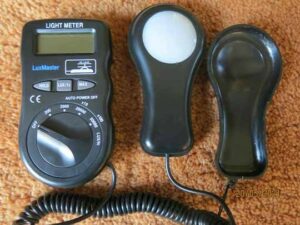Main Body
22 LIGHT METERS
Some photometric instruments can also measure scotopic illuminance and luminance using the CIE scotopic sensitivity function (page 52). Other can measure color – colorimeters. (There are various types, but that is also another story.18)
ILLUMINOMETERS p. 83
These are the instruments for measuring illuminance (rate and density of light received at some location) in terms of lux.
Often called “light meters”, they are simple to use and relatively inexpensive. Photographic light meters are generally of this type, and it is possible to convert their exposure readings to lux.31 Illumination meters range in price from under $100 to several hundred dollars. Their cost relates to their
- sensitivity – for use in dim lighting,

- accuracy,
- long term stability.
This one cost under $100 and uses two AA batteries:
Having the white sensor separate makes it easier to read without blocking the light.
The 200 lux scale would be useful for living rooms and hallways; the 2000 scale for work areas such as offices and classrooms.
p. 84
Here are some examples of various measured levels of common illumination in lux:
|
CONDITION |
ILLUMINANCE (lux) |
|
direct sunlight |
110,000 |
|
daylight |
11,000 |
|
overcast day |
1,100 |
|
drafting & assembly rooms |
1,000 |
|
recommended classroom |
300 |
|
dark day |
108 |
|
typical living room |
50 |
|
early twilight |
10.8 |
|
late twilight |
1.08 |
|
full moon |
0.11 |
|
quarter moon |
0.011 |
|
starlight |
0.001 |
|
overcast night |
0.0001 |
PHOTOMETERS p. 85
These instruments measure luminance (the rate and density of light emitted or received from some direction) in terms of candela-per-meter2).

A lens focuses a light source, a display, or a surface that reflects light onto a photosensor.32
Instruments for general applications provide a display of the overall field of view together with an indicator for the specific area being measured.
The added complexity raises their cost to over 10 times that of illuminometers. Still more expensive models have the equivalent of a filter wheel that enables making radiometric and colormetric measurements. Costs also increase with increasing accuracy, duration of accuracy, provision for internal calibration, selectable measuring field size, and how small an area can be measured.
However, with proper arrangement of the measuring situation and a bit of math, it is possible to measure luminance with a simple illuminometer. 30
p. 86
Here are the luminance values of everyday sources of brightness.
|
LIGHT SOURCE |
LUMINANCE (cd/ m 2) |
|
the sun (Do not look at it!) |
10,000,000 |
|
maximum eye tolerance |
6,000 |
|
60 watt incandescent light bulb |
2,700 |
|
full moon |
2,500 |
|
white paper in full sun |
2,500 |
|
white paper under cloudy sky |
1,000 |
|
white paper in drafting & assembly lighting |
250 |
|
white paper in classroom lighting |
75 |
|
white paper 1 meter from 60 watt bulb |
18 |
|
white paper in living room lighting |
12 |
|
white paper in minimal light for color |
1 |
|
white paper in full moon light |
0.06 |
|
dimmest visible light |
0.003 |
